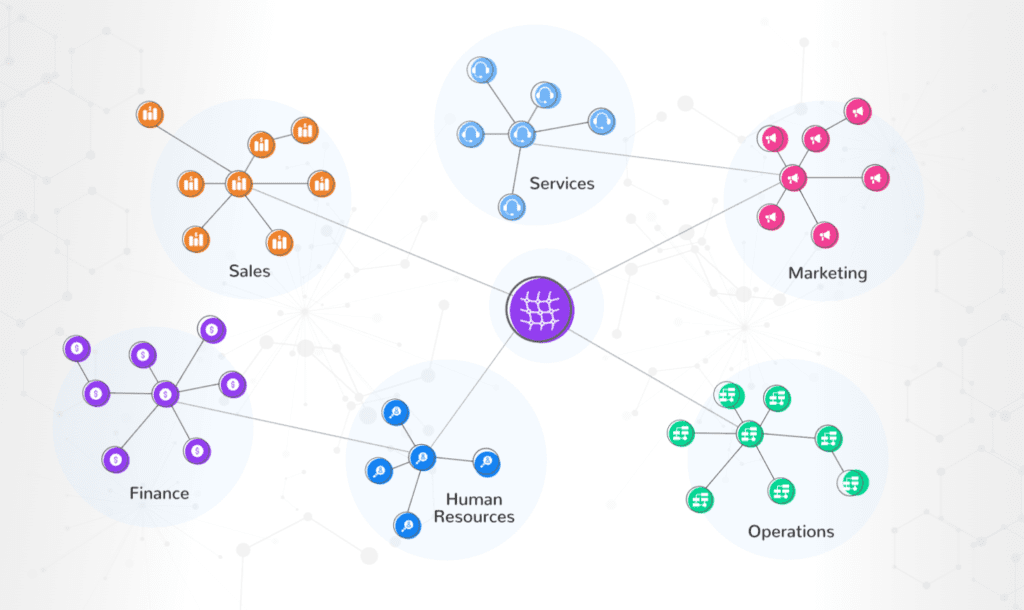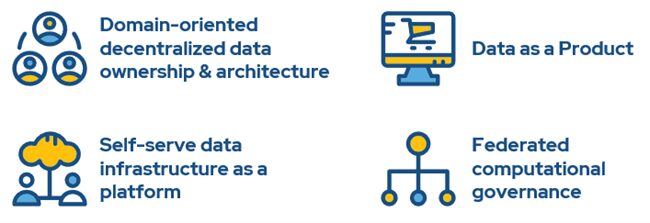
Seth Rao
CEO at FirstEigen
Data Mesh Architecture: A Complete Guide to Principles, Benefits, and Implementation
Is your organization ready to implement a data mesh architecture? Building a data mesh involves transitioning from a centralized to a decentralized data management model. You need to create a framework that pushes data storage and management from a monolithic entity to multiple data domains while improving access and scalability. To do this, you need to know the principles of data mesh architecture and how to apply them in the real world.
Quick Takeaways
- A data mesh is a distributed framework for decentralized data storage and management.
- The four principles of data mesh are data as a product, domain-oriented ownership, self-service data infrastructure, and federated data governance.
- A data mesh architecture improves data visibility, scalability, flexibility, and collaboration.
- To build a data mesh architecture, start by assigning independent data product teams, defining data domains, and implementing company-wide data governance policies.
What is a Data Mesh?
A data mesh is a distributed framework designed for managing data in large organizations. Unlike traditional centralized data architectures, a data mesh takes a decentralized data approach, weaving data storage and access into a mesh-like structure. This architecture incorporates data from multiple sources and stores it in a way that allows easy access for individuals and teams throughout the organization. Though more complex than a centralized structure, a data mesh offers superior data access, scalability, and security.

What is Data Mesh Architecture?
Data Mesh Architecture is a decentralized framework designed to democratize data management across organizations. Unlike traditional centralized models where data resides in a single data warehouse or lake, a data mesh distributes data ownership across domains—specific business units or teams—while ensuring seamless integration and accessibility.
This architecture enables better scalability, as data is managed by the teams closest to it. It also improves collaboration and agility, making it a preferred choice for large enterprises transitioning to modern data strategies.
Benefits of Data Mesh Architecture
According to the Data and Analytics Leadership Annual Executive Summary 2023, 41.5% of leaders surveyed plan to invest in data mesh in 2023. This pivot from centralized to decentralized data architecture is driven by several reasons, including the following:
- Easy scalability. With a mesh architecture, managing more data is as simple as adding more nodes. The decentralized nature of a mesh network means that no major system upgrades are necessary. Growth comes either by dispersing data throughout the mesh or adding low-cost servers in new nodes.
- Democratic data processing. Unlike centralized systems where a single entity controls data management, data mesh spreads control to domain experts who can create more meaningful data products.
- Increased flexibility. It’s easier to make changes to a decentralized structure than a centralized one. This prevents bottlenecks and enables the system to evolve as necessary.
- Lower costs. Distributed data architectures run more efficiently, are less prone to catastrophic failures, are easier to repair, and can be upgraded at less cost. The result is lower operating and storage costs.
- Improved data visibility and access. Wakefield Research reports that 69% of data executives find their organizations’ data trapped in silos and not fully utilized. Data mesh makes all data available to all users, reducing silos and enhancing collaboration.
- Increased collaboration. A data mesh architecture eliminates inefficient data silos. This enables and encourages collaboration between teams, which is less doable with centralized structures.
- Enables remote work. Remote workers become additional in a data mesh, simplifying access for a growing remote workforce.
Why Should Organizations Consider Data Mesh Architecture?
Adopting a data mesh architecture can revolutionize analytics and data management, addressing the challenges of scale and accessibility while empowering teams across an organization.
In traditional centralized systems, challenges such as data bottlenecks and reliance on a central ETL pipeline often arise. For instance, when data teams are required to run multiple transformations simultaneously, processing can slow down significantly. This not only hinders efficiency but also puts immense operational pressure on data engineers and scientists, who are often inundated with requests from business users. These users depend heavily on technical teams to extract insights and derive value from the data, leaving little room for strategic innovation.
By shifting the responsibility of extracting value from data to data product owners, data mesh architecture transforms this dynamic. This shift liberates data technologists to focus on strategic initiatives that enhance the overall value of data across the organization.
Furthermore, data mesh promotes data democratization, enabling every data consumer—whether a data scientist, analyst, or business manager—to seamlessly access, analyze, and derive insights from any data source without the constant involvement of data engineers. This streamlined accessibility fosters a culture of agility, collaboration, and innovation.
With the data mesh architecture, organizations can overcome operational inefficiencies, empower domain teams, and unlock the full potential of their data ecosystem.
Ensure 100% Data Quality in Your Data Mesh
Understanding the Four Key Data Mesh Principles
Understanding the four core principles inherent in a data mesh is essential for building an efficient network.

1. Data as a Product
In a data mesh, data is not merely a resource but a product with defined ownership and accountability. Each data product is a valuable asset.
A data product should be:
- Discoverable
- Addressable
- Trustworthy
- Self-describing
2. Domain-Oriented Ownership
A data mesh requires domain-oriented ownership. There is no centralized entity owning all the organization’s data. Instead, ownership is delegated to the teams closest to the data they use.
3. Self-Service Data Infrastructure
With decentralized data ownership comes decentralized management. Teams require tools and services to manage their data storage and processing independently. All data management is self-service.
4. Federated Data Governance
In a data mesh, data security is a shared responsibility. Leadership must establish company-wide standards and policies for data quality and security, which individual domain owners must implement.
Establishing a Data Mesh Architecture, Step by Step
How best can your organization create a data mesh architecture? While the task can seem daunting, it simply requires following these basic steps.
1. Form Data Product Teams
Transitioning from a centralized to a decentralized structure requires creating cross-functional teams within each data domain. Each team should include data engineers and domain experts.
2. Analyze Existing Data
Before you convert any data, you need to understand your current data. Catalog your existing data and assign detailed metadata to know what you’re working with.
3. Define Data Domains
Organize your analyzed data into logical business domains, either by location, department, business unit, or other relevant factors. This domain organization will shape your mesh structure.
4. Define Data Products
Each data domain should then define data products that are important to the consumers of their data. These data products should be clearly defined with a target audience in mind.
5. Establish Data Quality Guidelines
While data management is domain-specific, data quality standards should be dictated from above. Each domain team should work with similar data quality monitoring tools to maintain consistent quality throughout the organization.
6. Implement Federated Data Governance Policies
Likewise, data governance policies should be set at a company-wide level. Federated data governance should define standards for data schemas, naming conventions, access controls, and the like.
7. Choose the Right Technologies
Should your data mesh exist on-premises or in the cloud? Assess if existing data warehouses and lakes can be integrated into your new mesh. You need to determine the right technologies for your data mesh needs.
8. Monitor, Scale, and Evolve
Your work isn’t done when you flip the switch on your new data mesh. You need to monitor mesh performance to determine what’s working and what isn’t, then fine-tune your system for better performance. You also need to scale and evolve your mesh as your data needs change and grow. It’s a never-ending iterative process.
Achieve Flawless Data Mesh Quality with DataBuck’s Real-Time Monitoring!
Use DataBuck to Monitor Data Mesh Data Quality
Whichever type of data architecture your organization uses, data quality is imperative. This is especially true with a data mesh architecture, where data is ingested from multiple sources and distributed via multiple data domains. FirstEigen’s DataBuck uses artificial intelligence technology to monitor all data ingested into and flowing through a data mesh. It identifies and either cleanses or deletes questionable data in real time, ensuring consistent, high-quality data throughout the mesh.
Contact FirstEigen today to learn more about data quality in data meshes.
Check out these articles on Data Trustability, Observability & Data Quality Management-
- 6 Key Data Quality Metrics You Should Be Tracking
- How to Scale Your Data Quality Operations with AI and ML?
- 12 Things You Can Do to Improve Data Quality
- How to Ensure Data Integrity During Cloud Migrations?
- Data Observability Tools AWS
- Anomaly Detection for Data Quality
- Traditional Data Warehouse Architecture
- Data Mesh vs Data Fabric vs Data Lake
FAQ
Data Mesh Architecture is a decentralized approach to managing and sharing data across domains, focusing on treating data as a product and enabling self-serve access.
The four core principles of Data Mesh include decentralized data ownership, data as a product, self-serve data infrastructure, and federated data governance.
Data Mesh addresses bottlenecks in centralized data systems by decentralizing ownership, improving scalability, democratizing data access, and enabling faster decision-making.
While Data Lakes focus on storing unstructured data centrally, Data Mesh decentralizes data ownership, allowing teams to manage data products independently with a focus on scalability and domain-specific needs.
Common Data Mesh tools include platforms for data lineage, governance, and monitoring, such as Monte Carlo, Databricks, and Snowflake, which support federated data ownership and self-service analytics.
Implementing Data Mesh can involve cultural changes, decentralized governance complexities, and the need for robust data infrastructure across domains.
Discover How Fortune 500 Companies Use DataBuck to Cut Data Validation Costs by 50%
Recent Posts
Get Started!



